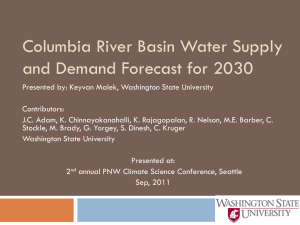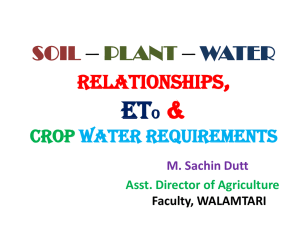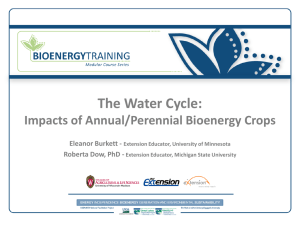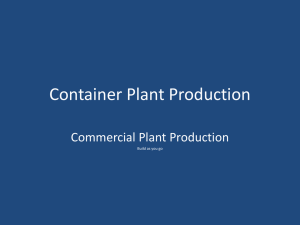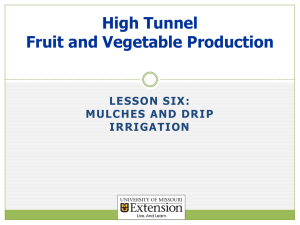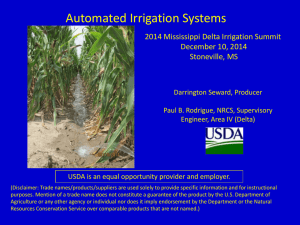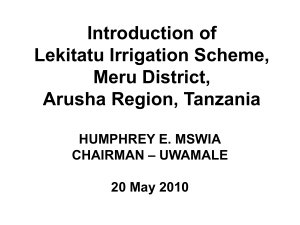Chapter-2-3-Crop water requirement-AAU-2014
advertisement
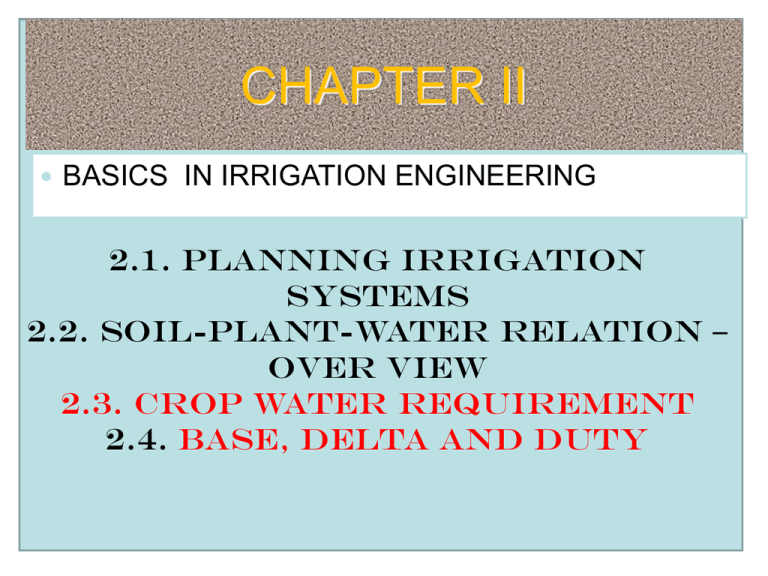
CHAPTER II BASICS IN IRRIGATION ENGINEERING 2.1. Planning Irrigation systems 2.2. soil-plant-water relation – over view 2.3. Crop water requirement 2.4. Base, delta and duty 2.3. CROP WATER REQUIREMENTS • It is defined as “the depth of water needed to meet the water loss through evapotranspiration (ETcrop) of a disease free crop growing in large fields under non-restricting soil conditions including soil water and fertility and achieving full production potential under the given growing environment”. • It is the quantity of water required by the crop in a given period of time to meet its normal growth under a given set of environmental & field conditions. CROP WATER REQUIREMENTS cont.. • The determination of water requirements is the main part of the design and planning of an irrigation system. • The water requirement is the water required to meet the water losses through – Evapotranspiration (ET) – Unavoidable application losses – Other needs such as leaving preparation & land CROP WATER REQUIREMENTS cont.. • The water requirement of crops may be contributed from different sources such as irrigation, Effective rainfall, Soil moisture storage and ground water contributions. • Hence, WR = IR + ER + S + GW • Where, IR = Irrigation requirement ER = Effective rainfall S = carry over soil moisture in the crop root zone GW = ground water contribution Irrigation requirement of Crops • Irrigation water requirement of crops is defined as the part of water requirement of crops that should be fulfilled by irrigation • In other words, it is the water requirement of crops excluding effective rain fall, carry over soil moisture and ground water contributions. WR=IR +ER + S +GW IR= WR-(ER+S+GW) Effective Rainfall (ER) • Effective rainfall can be defined as the rainfall that is stored in the root zone and can be utilized by crops. • All the rainfall that falls is not useful or effective. • As the total amount of rainfall varies, so does the amount of useful or effective rainfall. • Some of the seasonal rainfall that falls will be lost as unnecessary deep percolation; surface runoff and some water may remain in the soil after the crop is harvested. • From the water requirement of crops point of view, this water, which is lost, is ineffective. • • • • Effective Rainfall (ER) cont… People in different disciplines define effective rainfall in different ways. To a canal irrigation engineer, it is the rainfall that reaches the storage reservoir, to a hydropower engineer, it is the rain fall that is useful for running the turbines and for Ground water engineers or Geo – hydrologists, it is that portion of the rainfall that contributes to the ground water reservoir Effective Rainfall (ER) cont… • CropWat 4 Windows has four methods for calculating the effective rainfall from entered monthly total rainfall data. • Fixed Percentage Effective Rainfall • The effective rainfall is taken as a fixed percentage of the monthly rainfall; • Effective Rainfall = % of Total Rainfall Dependable Rain • An empirical formula developed by FAO/AGLW based on analysis for different arid and sub-humid climates. • Effective Rainfall = 0.6 * Total Rainfall - 10 ... (Total Rainfall < 70 mm) • Effective Rainfall = 0.8 * Total Rainfall - 24 ... (Total Rainfall > 70 mm) Empirical Formula for Effective Rainfall • This formula is similar to FAO/AGLW formula (see Dependable Rain method above) with some parameters left to the user to define. • Effective Rainfall = a * Total Rainfall - b ... (Total Rainfall < z mm) • Effective Rainfall = c * Total Rainfall - d ... (Total Rainfall > z mm) • where a, b, c, and z are the variables to be defined by the user. Method of USDA Soil Conservation Service (default) • The effective rainfall is calculated according to the formula developed by the USDA Soil Conservation Service: • Effective Rainfall = Total Rainfall / 125 * (125 0.2 * Total Rainfall) …(Total Rainfall < 250 mm) • Effective Rainfall = 125 + 0.1 * Total Rainfall .. (Total Rainfall > 250 mm) Ground water contribution (Gw): • Some times there is a contribution from the groundwater reservoir for water requirement of crops. • The actual contribution from the groundwater table is dependent on the depth of ground water table below the root zone & capillary characteristics of soil. • For clayey soils the rate of movement is low and distance of upward movement is high while • for light textured soils the rate is high and the distance of movement is low. • For practical purposes the GW contribution when the ground water table is below 3m is assumed to be nil. Carry over soil moisture(S): • This is the moisture retained in the crop root zone b/n cropping seasons or before the crop is planted. • The source of this moisture is either from the rainfall that man occurs before sowing or it may be the moisture that remained in the soil from past irrigation. • This moisture also contributes to the consumptive use of water and should be deducted from the water requirement of crops in determining irrigation requirements. Net Irrigation Requirement (NIR) • After the exact evapotranspiration of crops have been determined the NIR should be determined. • This is the net amount of water applied to the crop by irrigation exclusive of ER, S and GW. • NIR = WR – ER –S –GW • The word ‘net’ is to imply that during irrigation there are always unavoidable losses as runoff and deep percolation. • NIR is determined during different stages of the crop by dividing the whole growing season into suitable intervals. • The growing season is more preferably divided into decades. • The ETcrop during each decade is determined by subtracting these contributions from the ETcrop. Gross irrigation requirement (GIR) • Usually more amount of water than the NIR is applied during irrigation to compensate for the unavoidable losses. • The total water applied to satisfy ET and losses is known as Gross irrigation requirement (GIR) • GIR =NIR Ea • Where Ea =application efficiency Evapotranspiration: • This includes the water lose evaporation and transpiration. through a) Evaporation: - is the process by which a liquid changes into water vapor, which is water evaporating from adjacent soil, water surfaces of leaves of plants. • In irrigation this is applied for the loss of water from the land surface. Transpiration: • Transpiration: - is the process by which plants loose water from their bodies. • This loss of water includes the quantity of water transpired by the plant and that retained in the plant tissue. • That is, the water entering plant roots and used to build plant tissue or being passed through leaves of the plant into the atmosphere. Potential Evapotranspiration (PET): • This is also evapotranspiration called reference crop • it is the rate of evapotranspiration from an extensive surface 8 to 15 cm tall, green grass cover of uniform height, actively growing, completely shading the ground and not short of water”. • Under normal field conditions, the potential evapotranspiration does not occur and thus suitable crop coefficients are used to change ETo to actual evapotranspiration of the crops. Consumptive use (CU) of water and methods of estimation • Consumptive use (CU) is synonymous to evapotranspiration (ETcrop). • Consumptive use:- is the depth (quantity) of water required by the crop to meet its evapotranspiration losses and the water used for metabolic processes. • But the water used for metabolic processes is very small & accounts only less than 1 % of evapotranspiration. Consumptive use (CU) cont… • Hence the consumptive use is taken to be the same as the loss of water through evapotranspiration. • Note: CU= ET + water used by the plants in their metabolic process for building plant tissues (insignificant) • It involves: – Problems of water supply – Problems of water management – Economics of irrigation projects • CU use can apply to water requirements of a crop, a farm, a field and a project. • However, when the CU of the crop is known, the water use of larger units can be calculated. Calculation of crop water requirement • Prediction methods for crop water requirements are used owing to the difficulty of obtaining accurate field measurements. • The methods often need to be applied under climatic and agronomic conditions vary different from those under which they were originally developed. • To calculate ETcrop a three-stage procedure is recommended 1. The effect of climate given by the reference crop evapotranspiration (ETo). • The methods to calculate ETo presented here in are – – – – the Blaney-Criddle method, Thornthwaite method, the Hargeaves class A evaporation method and the penman method. • These methods are modified to calculate ETo using the mean daily climatic data for 30 or 10 days periods. • The choice of the method must be based on: – the type of climatic data available and – on the accuracy required in determining water needs. 2. The effect of crop characteristics. • This is given by the crop coefficient (Kc) which presents the relationship between ETo and ETcrop. • ETcrop= Kc . ETo • - Values of Kc vary with the type of crop its stage of growth growing season and the prevailing weather conditions 3. Effect of local conditions and agricultural practices • This includes: - the variation in climate over time - size of field - distance and altitude - soil water availability - Irrigation and cultivation methods and practices. Factors Affecting Consumptive Use of Water: - • The consumptive use of water – is not constant throughout the stages of the crop and also – varies for different types of crops. • Generally the factors affecting consumptive use of water can be classified as – climatic factors. – crop factors A. Climatic factors • Temperature: As the temperature increases, the saturation vapor pressure also increases and results in increase of evaporation and thus consumptive use of water. • Wind Speed: The more the speed of wind, the more will be the rate of evaporation, because the saturated film of air containing the water will be removed easily. • Humidity: - The more the air humidity, the less will be the rate of consumptive use of water. This is because water vapor moves from the point of high moisture content to the point of low moisture content. So if the humidity is high water vapor cannot be removed easily. • Sunshine hours: - The longer the duration of the sunshine hour the larger will be the total amount of energy received from the sun. This increases the rate of evaporation and thus the rate of consumptive use of crops. B. Crop factors • The agronomic feature of the crops is variable, some crops completely shade the ground while others shade only some part of the ground. • To account these variations in the nature of the crop suitable values of crop coefficient are used to convert the PET to actual evapotranspiration. • So for the same climatic conditions different crops have different rates of consumptive uses Determination of Consumptive Use of water • Under normal field conditions PET (ETo) will not occur and thus consumptive use (ETcrop) can be determined by determining the ETo and multiplying with suitable crop coefficients (Kc). • Alternatively it can be determined by direct measurements of soil moisture. 1. Direct Measurement of Consumptive Use: • A) Lysimeter experiment • B) Field experimental plots • C) Soil moisture studies • D) Water balance method • • • • a. Lysimeter Experiment Lysimeters are large containers having pervious bottom. This experiment involves growing crops in lysimeters there by measuring the water added to it and the water loss (water draining) through the pervious bottom. Consumptive use is determined by subtracting the water draining through the bottom from the total amount of water needed to maintain proper growth. ETc = IR + Eff.P +or –soil moisture- Drainage • • • • • b. Field Experimental Plots This is most suitable for determination of seasonal water requirements. Water is added to selected field plots, yield obtained from different fields are plotted against the total amount of water used. The yield increases as the water used increases for some limit and then decreases with further increase in water. Production function The break in the curve indicates the amount of consumptive use of water. C. Soil Moisture Studies: • In this method soil moisture measurements are done before and after each irrigation application. • Knowing the time gap b/n the two consecutive irrigations, the quantity of water extracted per day can be computed by dividing the total moisture depletion b/n the two successive irrigations by the interval of irrigation. • Then a curve is drawn by plotting the rate of use of water against the time from this curve, seasonal water use of crops is determined • • • • • d. Water balance method This method is used for determination of consumptive use of large areas. It is expressed by the following equation. Precipitation = Evapotranspiration + surface runoff + deep percolation + change in soil water contents Except evapotranspiration, all the factors in the above equation are measured. Evapotranspiration is determined from the above equation 2. Determination of Evapotranspiration using equations • Blaney- Criddle method • This method is suggested where only temperature data are available. • ETo = C[ P (0.46T+8)] mm/day • Where • ETo= reference crop evapotranspiration in mm/day for the month considered. • T= mean daily temperature in oc over the month • P= mean daily percentage of total annual day time hours obtained from table 1 for a given month and latitude. • C = adjustment factor which depends on minimum relative humidity, sunshine hours and daytime wind estimates Blaney- Criddle method • Figure 1 can be used to estimate ETo using calculated values of p(0.46T+8) for • i) three levels of minimum humidity (RH min) • ii) three levels of the ratio of actual to maximum possible sunshine hours (n/N) and • iii) three ranges of daytime wind conditions at 2m height (Uday). • • • • • Blaney- Criddle method Note: Minimum humidity refers to minimum daytime humidity wind refers to daytime wind. Generally Uday/Unight =2 and mean 24 hr wind data should be multiplied by 1.33 to obtain mean daytime wind. After determining ETo, ETcrop can be predicted using the appropriate crop coefficient (Kc). ETcrop= Kc * ETo • • • • simplified form of Blaney- Criddle A more simplified form of Blaney- Criddle equation in which the potential evapotranspiration ( consumptive use ) depends only in the mean monthly temperature and monthly day light hours is given as : u = Kf Where u= monthly consumptive use ,m K = empirical crop coefficient F = monthly consumptive use factor simplified form of Blaney- Criddle • The monthly consumptive use factor • Where p is monthly day light hours expressed as a percentage of the total day light hours of the year . • It depends on the latitude of the location. • Tm is mean monthly temperature in oC. Obtain values of P from standard tables. simplified form of Blaney- Criddle • The crop coefficient K depends on the location and type of crop . • Values varies according to the different stage of crop growth period. • This method gives good results if the value of K is selected judiciously after field test. • Where n= number of months in crop period Blaney- Criddle • Limitation: This method is an approximate method , since it doesn’t consider a number of important factors such as humidity , wind velocity and altitude Example on Blaney- Criddle on your lectrure Note Assignment Thornthwaite method • According to the Thornthwaite equation , based on the data from the eastern U.S.A , the monthly consumptive use or the potential evapotranspiration is given by • Where , Tm = mean monthly temperature in oC. I = annual heat index , obtained from monthly heat index I of the year Thornthwaite method + • The values of the exponents a and b are obtained from the relation Thornthwaite method Example on Thornthwaite on your lecture Note Assignment • • • • • • Hargreaves class A pan Evaporation ET or CU is related to pan evaporation (EP) by a constant Kc, called consumptive use coefficient. ET = Kc * Ep Determination of Ep (a.) Experimentally (b.) Christiansen formula Ep = 0.459R * Ct*Cw*Ch*Cs*Ce Ct = Coefficient for temperature Ct = 0.393 +0.02796Tc +0.0001189 Tc2 Tc= mean temperature, oc Hargreves method Cw = Coefficient for wind velocity Cw= 0.708 + 0.0034 v - 0.0000038 v2 v=mean wind velocity at 0.5m above the ground, km/day. Ch= Coefficient for relative humidity. Ch= 1.250 - 0.0087H - 0.75*10-4H2 –0.85*10-8H4 H= mean percentage relative humidity at noon Cs= Coefficient for percent of possible sunshine Cs= 0.542+0.008 S-0.78*10-4 S2 +0.62*10-6S3 S= mean sunshine percentage Ce= Coefficient of elevation Ce= 0.97+ 0.00984E E= elevation in 100 of meters • • • • Modified Penman Method A slightly modified penman equation from the original (1948) is suggested here to determine ETo involving a revised wind function term. The method uses mean daily climatic data, since day and night time weather conditions considerably affect level of ET; an adjustment for this is included. The modified penman equation is , ETo = c ( W.Rn + (1 – W) * f(u). (ea – ed)) Radiation Aerodynamic term Term • • • • Modified Penman Method Where: ETo = reference crop evapotranspiration ,mm/day W = temperature – related weighting factor Rn = net radiation in equivalent evaporation in , mm/day • F(u) = Wind – related function • (ea-ed) = difference between the saturation vapor pressure at mean air temp. and the mean actual vapor pressure of the air in mbar. • C = adjustment factor to compensate for the effect of day and night weather conditions. Modified Penman Method • For areas where measured data on temperature, humidity, wind and sunshine duration or radiation are available, the penman method is suggested. The penman equation consists of two terms: - the energy (radiation) term and - The aerodynamic (wind and humidity) term. • The relative importance of each term varies with climatic conditions. • Under calm weather conditions the aerodynamic term is usually less important than the energy term. • It is more important under windy conditions and particularly in the more arid regions. Modified Penman Method • Due to the interdependence of the variables composing the equation, the correct use of units in which variables need to be expressed is important (see example below). • Description of variables and their Method of calculation a. Vapor pressure (ea-ed) • Air humidity affects ETo. • Humidity is expressed here as saturation vapor pressure deficit (ea-ed), • (ea-ed) is the difference between mean saturation water vapor pressure (ea) and the mean actual vapor pressure (ed). Modified Penman Method • Air humidity data are reported as: - Relative humidity (RH max ad RH min in percentage) - Psychometric readings (ToC of dry and wet bulb) from wet and dry bulb thermometers, or as a dew point temperature j (T dew point oC) • Time of measurement is important, but is often not given. • Fortunately actual vapor pressure (ed) is a fairly constant element and even one measurement per day may suffice. • Vapor pressure must be expressed in mbar. If ed is given in mm Hg multiply by 1.33 to find mbar. • Tables 5 and 6 give values of ea and ed from available climatic data. • • • • • • e) Net radiation (Rn). Net radiation (Rn) is the difference between all incoming and out going radiation. It can be measured, but such data are rarely available. Rn can be calculated from solar radiation or sunshine hours (or degree of cloud cover), temperature and humidity data. The amount of radiation received at the top of the atmosphere (Ra) is dependent on - latitude and - time of the year (Table 10). e) Net radiation (Rn). • Part of Ra is absorbed and scattered when passing through the atmosphere the remainder, including some that is scattered but reaches the earth’s surface is called the solar radiation (Rs). • Rs is dependent on Ra and the transmission through the atmosphere that is dependent on cloud cover. e) Net radiation (Rn). • Part of Rs is reflected back directly by the soil and crop and is lost to the atmosphere. • Reflection (α) depends on the nature of the surface cover and is approximately 5 to 7% for water and around 15 to 25% for most crops. • (i.e. it depends on crop cover and wetness of the exposed soil surface). • That, which remains is net short-wave solar radiation (Rns). e) Net radiation (Rn). • Additional loss at the earth’s surface occurs since the earth radiates part of its absorbed energy back through the atmosphere as long wave radiation. • This is normally greater than the down coming long wave atmospheric radiation. e) Net radiation (Rn). • The difference between out going and in coming long wave radiation is called net long wave radiation (Rn ℓ ). • Since outgoing is greater than incoming, Rn represents net energy loss. • Total net radiation (Rn ) = Rns – Rnɭ . • Radiation can be expressed in different units. • It can be given as the energy required to evaporate water from an open surface and is given here as equivalent evaporation in mm/day. e) Net radiation (Rn). To calculate Rn the steps are i) If measured Rn is not available, select Ra value in mm/day from Table 10 for given month and latitude. ii) To obtain Rs , correct Ra value for n/N iii) For most crops α = 0.25 Table 12 can be used to calculate Ras from the ratio n/N and α = 0.25. iv) Not long wave radiation (Rnɘ) can be determined from T, ed and n/N. Values for the function f (T), f(ed) and f(n/N) are given in Tables 13, 14, and 15 respectively. • v) To obtain total net radiation (Rn), the algebraic sum of Rns and Rnl is calculated. • Rnl always constitutes a net loss so Rn = Rns - Rnl. f) Adjustment factor (C) • The Penman equation given assumes the most common conditions where - radiation is medium to high - RH max is medium to high - Moderate daytime wind about double the night time wined. • However, these conditions are not always met. • For other conditions the penman equation should be corrected (Table 16 for values of C depending on RHmax , Rs , U day and U day / U night ) Example on modified penman and Radiation on your lecture Note Assignment Irrigation Efficiencies • i) Water storage efficiency • is the amount of water actually stored in the subject area expressed as a percentage of the volume of water that can be stored. • The general form of the Es equation is given as follows. Where Z = amount infiltrated (m3 . m-1 ) L = channel length (m) Lov = length of that part of the channel that received an amount of water equal to or in excess of the perceived requirements (m) Zr = required amount of application (perceived requirements ) (m3 . m-1 ) ii- Water Distribution Efficiency (Ed) • This shows how uniformly water is applied to the field along the irrigation run. • In sandy soils there is generally over irrigation at upper reaches of the run where as in clayey soils, there is over- irrigation at the lower reaches of the run. Where Ed = water distribution efficiency d = average depth of water penetration. y = average deviation from d. iii- Field Canal Efficiency (Ef) • This is a measure of the efficiency with which the water is conveyed through the field channels until it feeds the plots Where, Ef = Field canal efficiency Wp = water delivered to the plot at the head of furrows and strips Wf = water delivered to the field channel iv- Water Use Efficiency • This shows the yield of the crop per unit volume of water used. • It may be expressed in Kg/ha.cm or q/ha.cm • A. Crop Water Use Efficiency: is the ratio of the crop yield (Y) to the amount of water consumptively used by the crop. B. Field Water Use Efficiency: is the ratio of the crop yield (y) to the total water requirement of crops including Cu losses and other needs. • • • • • v- Project Efficiency (Ep) This shows how efficiently the water source used in crop production. It shows the percentage of the total water that is stored in the soil and available for consumptive requirements of the crop. It indicates the overall efficiency of the systems from the head work to the final use by plants for Cu. It is given as Ep = Ec * Eb * Ea IRRIGATION SCHEDULING • Scheduling of irrigation application is very important for successive plant growth and maturity. • Water is not applied randomly at any time and in any quantity. • Irrigation scheduling is the schedule in which water is applied to the field. • If in an important aspect of an efficient operation of an irrigation system. • The scheduling of irrigation can be field irrigation scheduling and field irrigation supply schedules. • Field irrigation Scheduling is done at field level. • The two scheduling parameters of field irrigation scheduling are the depth of irrigation and interval of irrigation. 1. Depth of irrigation (d) • This is the depth of irrigation water that is to be applied at one irrigation. • It is the depth of water that can be retained in the crop root zone b/n the field capacity and the given depletion of the available moisture content. • All the water retained in the soil b/n FC and PWP is not readily available to crops. • The readily available moisture is only some percentage of the total available moisture. • Thus, depth of irrigation is the readily available portion of the soil moisture. • it is the depth of irrigation water required to replenish the soil moisture to field capacity. • • • • • • • • Depth of irrigation (d) is given by d(net) = As * D (FC – PWP) * P , m As = Apparent specific gravity of soil D = Effective root zone depth in m FC = water content of soil at F.C PWP = Water content of soil at PWP P = depletion factor Because of application losses such as deep percolation and runoff losses, the total depth of water to be applied will be greater than the net depth of water. • Gross depth of application Where Ea = Field application efficiency and other parameters as defined above • • • • 2. Interval of Irrigation (i) The interval of irrigation is the time gap in days b/n two successive irrigation applications. It depends on the type of the crop, soil type and climate conditions. Thus interval of irrigation depends on the consumptive use rate of the crop and the amount of readily available moisture in the crop root zone. The consumptive use rate of the crop varies from crop to crop and also • during different stages of the crop. • The RAM moisture also varies from soil to soil depending on soil water constants. • The interval (frequency) of irrigation is given by : Where, ETcrop(peak) is the peak rate of crop evapotranspiration in m/day. For the same crop and soil science the ETcrop (peak) goes on increasing from the initial stage to the development and mid season stage the interval of irrigation will go on decreasing and increasing during rate season stage. Field Irrigation Supply Schedules (Irrigation Scheduling in a Command Area) • This is the schedule of water supply to individual fields or command area. • is a schedule of the total volume of water to be applied to the soil during irrigation. • It depends on crop and soil characteristics. • • It is expressed as: - Where q= Stream size (application rate ) lit/sec • t = Application time in sec • Ea = Application efficiency • As = Apparent specific gravity • D = Effective root zone depth ,m • P = Depletion factor • A = Area of the command (field) in ha • From the above equation, if either of the application time or the stream size fixed, one of them can be determined. • In the above equation q.t indicates the total volume of water applied to the field during irrigation at the head of the field. • But the total volume of water diverted at the headwork will obviously be greater than this value, because there is loss of water during conveyance and distribution canals. Total volume of water diverted at the headwork • The total volume of water to be diverted is given by : Where Q = flow rate at the head work, let/sec. Ep = project efficiency and others as defined above. CHAPTER II BASICS IN IRRIGATION ENGINEERING 2.1. Planning Irrigation systems 2.2. soil-plant-water relation – over view 2.3. Crop water requirement 2.4. Base, delta and duty Duty – Delta relationship Duty of water: is its capacity to irrigate land. • It is the relation between the area of the land irrigated and the quantity of water required. • Thus Duty ( D ) is defined as the area of the land which can be irrigated if one cumec (m3/sec) of water was applied to the land continuously for the entire base period of the crop. • - It is expressed in hectares / cumecs. Duty – Delta relation ship • Base period (B): the base period is the period between the first watering and the last watering. • The base period is slightly different from the crop period which is the period between the time of sowing and the time of harvesting the crop. Duty – Delta relation ship • Delta (∆): is the total depth of water supplied to the crop during the entire base period. • If the entire quantity of applied water were spread uniformly on the land surface, the depth of water would have been equal to delta. • Thus the delta (in m) of any crop can be determined by dividing the total quantity of water (in ha-m) required by the crop by the area of the land (in ha) • The relation between duty, base period and delta, can be obtained as follows. • Considering the area of land of D-hectares. • If Duty is expressed in ha/cumecs the total quantity of water used in the base period of B days is equal to that obtained by a continuous flow of 1 cumec for B days. m3 If Delta ( ) is the total depth of water in meters supplied to the land of D- hectares, the quantity of water is also given by: Equating the volumes of water given in two egns. Where, D = in ha/cumec ∆ = in m B = in days Factors affecting Duty • Duty of water depends up on different factors. • In general, the smaller the losses, the greater is duty because one cumec of water will be able to irrigate larger area. • Type of soil • Type of crop and base period • structure of soil • Slope of ground • Climatic condition • Method of application of water • Salt content of soil • Duty of water may be improved by counter – acting all the factors that decrease it (by decreasing various losses). Example on Efficiency, depth and irrigation interval and Duty on your lecture Note Assignment Assignment –I will be given
